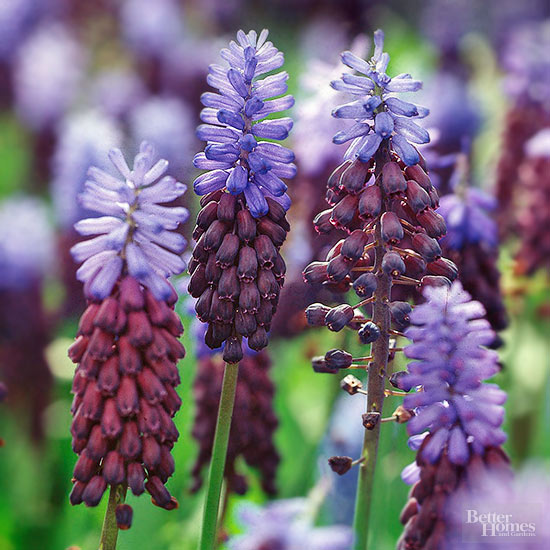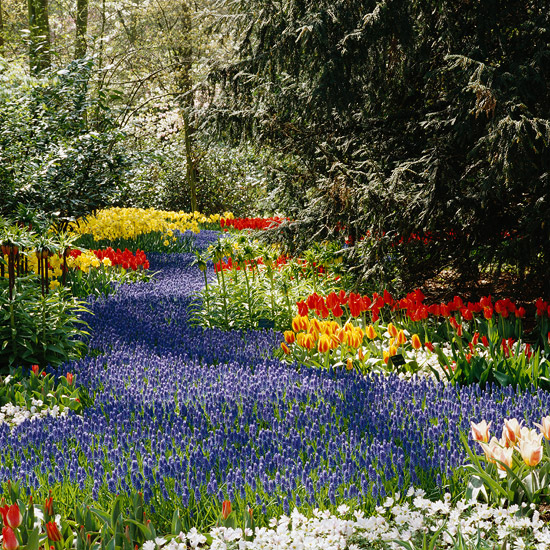






Imagine if you will, a brilliant blue "river" of flowers with a musky fragrance blooming in early spring. These are grape hyacinths (Muscari, from the Greek moschos or musk), one of the minor spring bulbs. Along with others, including crocus, squills (Scilla spp.), guinea hen flower (Fritillaria meleagris), and winter aconites (Eranthis hyemalis), grape hyacinths are planted in autumn with daffodils and tulips. As winter warms toward spring, these under-appreciated bulbs put on a glorious display that surely melts cold hearts with the hope of warmth and longer days to come.
Get detailed growing information for muscari in our Plant Encyclopedia.
continue reading belowSouthwestern Asia, North Africa, and the Mediterranean basin are home to some 30 species of Muscari, in assorted habitats: woodlands, rocky slopes of hills and mountains, and poor grasslands. In the British Isles and Europe, grape hyacinths have escaped and been naturalized for over 100 years. Look for them carpeting waste places, woodlands, and even sand dunes.
Formerly classified with lilies, grape hyacinths now belong to the asparagus family (Asparagaceae), along with glory-of-the-snow (Chionodoxa), and squills (Scilla). Their clusters of blossoms look somewhat like pointed clown caps, comprised of 30 or more tiny down-facing florets clustered in spikes atop leafless stems (scapes) 6–12 inches tall.
Colors range through all shades of blue, violet, yellow, pink, and white; M. latifolium has two-tone flowers of black-violet and blue. The shape and density of the spikes varies by species: those of M. azureum are stubby and short, elegant M. latifolium has slimmer spikes, while those of common grape hyacinth (M. botryoides) are triangular. The loose, yellow florets of M. macrocarpum face outward and are set wider apart on the stem; those of feather hyacinth (M. comosum 'Plumosum') are fluffy with threadlike florets. Each floret -- ranging from tubular to rounded to bell-like -- consists of six joined perianth parts (not delineated into petals and sepals) and is constricted at the mouth.
Common grape hyacinth bulbs produce two or more flower stems; other species throw just one. In fall the strap-shape, slightly succulent leaves emerge from the bulb and remain evergreen, though becoming tatty, through winter's cold. New leaves appear in spring just before bloom time. Up to a foot in length, leaf width depends upon the species: Tassel hyacinth has slender leaves ¼ to ¾ inches wide, while those of M. latifolium (pictured at top) might reach 2 inches across.

If you want to naturalize with grape hyacinths, choose a spot in your garden that receives full or part sun during the day; the bulbs grow fine under deciduous trees and shrubs or in the half shade of structures. An informal spot where they can spread without causing trouble is ideal. Grape hyacinths are very easy to please -- to the point where they can become invasive. Provide fertile, well-drained soil and avoid overly wet or heavily shaded sites. First clear the area and get rid of deep-rooted perennials (greedy pachysandra, and the like); clear the worst of the rocks. Loosen soil to 6 inches or more deep, and plant the small 2-inch tall bulbs about 3 -- 4 inches deep, nose up. Set them 2–4 inches apart; that works out to about two dozen bulbs per square foot.
For a large area, as for a "river," open up the area to be planted and put the soil to one side. Then place the bulbs over the whole area before replacing and firming the soil. Some people incorporate bulb food at planting time, but it is not really necessary except in very poor soil. A blue "pond" is planted the same way; in rock gardens you might consider "pools" of bulbs situated at differing heights to suggest a waterfall.
Firm and water thoroughly after planting, then mulch; keep an eye on the weather and water if there is little rainfall. In a few weeks after planting, don't be surprised to see foliage poking through. This is normal, and leaves should not be removed. More leaves and the flower buds start to emerge in a few months. After bloom, snap off the spent spikes to curtail seed formation, and conserve the bulbs' energy for the following spring. Leave foliage to ripen and yellow naturally before removing it.
Whether you outline an island bed, line a pathway, or plant a skirt for a tree, or just tuck some bulbs into an intimate corner, deer-resistant grape hyacinths are one of the joys of spring.
Browse top muscari varieties.
Learn how to force muscari.
Copyright © www.100flowers.win Botanic Garden All Rights Reserved